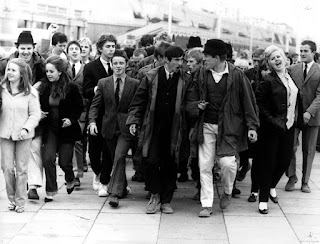
As a new generation of horror films change what we scream and cower at - or at least, get nervous watching on our couch at home - the techniques horror films employ have to adapt as well.
We are increasingly used to streaming and handmade handheld filmmaking on YouTube and reality television-based weblettes. A POV shot follows the protagonist through their homes, waiting for the reveal as it rounds the corner to show the mess in the living room, the girl undressing in the back, or the boat stashed in the leaves on the island.
Our response to such imagery is a combination of suspense and discomfort. We're not sure we're following the right people, that we're in good hands, that the plot will unfold satisfyingly - it being shot on-the-cuff - or even resolve, or is resolvable.
A sense of mediation in constructing film narratives gives us cold assurance, even as the films may be out to fornicate with our heads and create anxiety in such sensual blunderbuses as Saw, Irreversible and Funny Games. Yet such horror films (all stemming directly from the overly formalized experiments of Carpenter through to Tarantino) create mood, tension and plot by careful and methodical arrangements of shots and compositions. They all spectacularly show us what we want to see, but on their editorial terms.
They're not accidental. We get tense as we watch a character walk through the dark basement, the camera directly in front of the heroine, in too close - backing up, and we're unable to see what is ahead of her (although since she's facing forward and continues to walk, we assume there is nothing largely or visibly dangerous in her view ahead. Although whatever that may be is behind us and out of "our" sight.).
When the camera is instead behind her, following and in close as it moves with her, we may be able to see what's ahead of her (as she does) but unable to know what's creeping up just behind (besides us, and a steadicam rig. We want her to ... turn around!).
These are specific constructions that reveal to us visually only certain information and perversely withholds other (including the cat that is just about to jump or be dropped onto the heroine's shoulder). A well-constructed horror film manipulates and withholds, teasing out bits of eye candy and gruel in careful measure and juxtaposed in blunt and spectacular manner.
We enjoy this grand guignol display. When it works we give over to the sensual roller-coaster of confrontational and impossible logic, with a hidden design of frustration and surprises that reveals itself only in the process of our enrapture if not in the quoditian denoucement of the plot. A solid story well told is its own reward, and we laugh as we exit, wiping our flopsweat off our brows and telling ourselves it's only a movie.
The held shot, in suspense, is the single unit of horror that challenges our understanding of the underlying design, waiting to commit to an edit to which the intent of the protagonist is finally exposed, when he decides to go into the basement; when the filmmaker will withhold what's ahead and not behind; when the spectator must accept that what's about to be shown is texture rather than text.
The edit creates order. The edit, a collision of images, is a sequence like a sentence, constructed logically. It is in the edit that tension is created and then released, a question is asked and then answered, in which options are abandoned for the one that is chosen. The spirit becomes body, God becomes the word, the word becomes flesh. The comfort of storytelling becomes manifest. Seeing is good.
A handheld and undisiplined camera troubles us. We simply can't get our bearings. We wait for the angle to change so we can see more. Once we see past Jamie Lee Curtis to what's behind her, we discover how close the monster is, what the space is between them.
We wonder about the how rather than the what. The cut is comforting. It releases us from a film's grip, for an instant and instantly, in the space between 2 frames, and for a moment, we can relax.




























